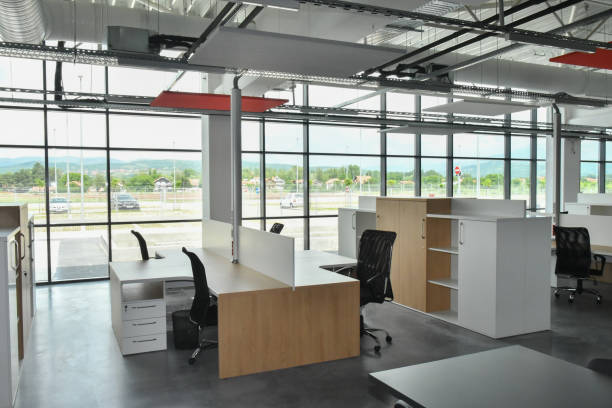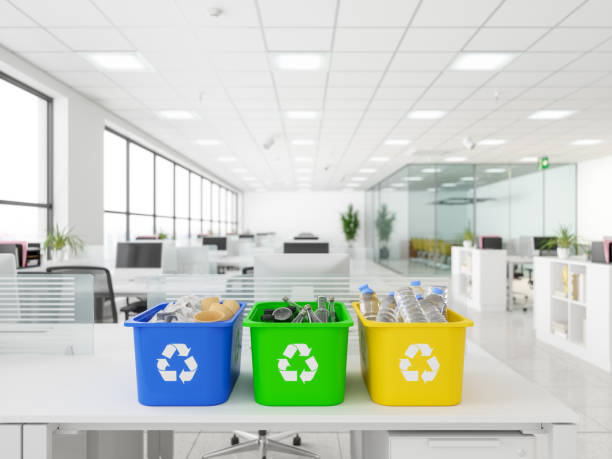Business owners now understand that they have a greater environmental impact, beyond what they sell or the services they render. As sustainability evolves, our work environments are undergoing revisions and restructurings as part of a more comprehensive approach. Where we work matters just as much as what we do.
We generate a staggering 11 million tons of trash each day as a result of global waste production, which is expected to increase until 2100. Every single day of the year, each person generates over a kilo of waste. This growing problem demands radical changes before it spirals out of control.
Even though many of us have adopted eco-friendly habits at home, we should extend these green practices to our workplaces as well. Zero waste should become a norm in office environments as sustainability and efficiency become more important. Reducing office waste benefits both our environment and our economy.
The transition to an eco-friendly workplace can be a significant cost-saving exercise for a business’ waste management system, as well as an exercise in sustainability. In addition to enhancing operational efficiency, simple but impactful changes can go a long way in facilitating the implementation of Zero Waste policies.
What is a Sustainable Office Environment?

A sustainable office is far more than just putting out the lights at the end of the day. It involves digitalizing processes and adopting policies to reduce paper usage, using lighting and equipment that use less energy, and encouraging employees to travel more efficiently (by bus, train, or carpooling), thereby reducing emissions.
This approach also emphasizes the importance of managing waste responsibly. Through recycling initiatives and composting, organizations reduce the amount of waste they send to landfills and create a culture that values the environment.
Reduce waste and recycle whenever possible by using eco-friendly materials. In biophilic design, indoor greenery is a priority. Furthermore, designing an eco-friendly workplace that utilizes natural light effectively contributes to fostering a healthy work environment.
15 Best Ways to Have a Sustainable Office Space

The following green practices will help you make your office more sustainable:
1. Go paperless!
By having a paperless office in the first place, we can make a greater difference than just implementing recycling initiatives. Digital alternatives can quickly replace paper in businesses where it is not irreplaceable.
With electronic devices and tools at your fingertips, you don’t need to create more paper waste in this digital age. Make sure your team does the following to ensure a paperless office space:
- Reduce the need for printing by using digital communication channels, such as messaging apps and emails. Write, edit, collaborate, sync, and share files online for free and easily through Google Docs and Dropbox.
- To streamline workflows and minimize paper-based processes, use online collaboration tools and project management tools.
- Eliminate excessive printing and archiving by embracing digital signatures and online documentation. Having a paperless office is realistic!
2. Reduce, Reuse, and Recycle
Incorporate green practices into your daily routine. To foster a culture of responsible waste management, the office should implement comprehensive recycling initiatives for paper, plastic, glass, and electronics. Encourage email, cloud storage, and electronic documents to reduce paper waste and promote a greener workplace by promoting a paperless environment.
Using reusable materials such as lunch packaging will complement these efforts. With these wraps, the office promotes a zero-waste lunch culture and minimizes disposable plastics and single-use plastic bags. A sustainable corporate gift can also be customized for your employees.
3. Embracing zero-waste shopping
An environmentally conscious approach to purchasing is essential to transformation. By buying recycled or sustainable office supplies, furniture, and electronics, you are making a positive environmental impact.
To support sustainability, we recommend buying in bulk and selecting recyclable products from zero waste stores. To reduce the environmental impact of office purchases, it is important to promote awareness among employees about the need to choose sustainable products.
In this way, your office will promote a greener, more environmentally friendly environment by supporting eco-friendly suppliers and establishing a culture of sustainable purchasing.
Read More On: 10 Best Eco-Friendly and Sustainable Zero Waste Shopping Tips
4. Avoid plastics
Plastic waste amounts to over 350 million tons a year. By 2060, this amount is predicted to reach one billion tons without policy changes. However, we can cut down this amount to about 700 million tons with better recycling programs.
To reduce plastic usage at coworking spaces, we can do the following:
- Don’t use single-use plastics like cutlery, bottles, and packaging.
- Encourage coworkers to reuse mugs and water bottles, and reduce the use of disposables.
- Utilize biodegradable or reusable materials as an alternative to plastic utensils and plates.
- Rather than throwing plastic waste into general office waste, aim to manage and recycle it more effectively. Designate a place for disposing of plastics.
- Make your coworking area water station sustainable by banning water bottles.
5. Encourage green transportation
To achieve environmental sustainability and zero waste office, promote green transportation within offices. Encourage carpooling, cycling, and public transportation. Also urge employees to reduce carbon emissions, and demonstrate a commitment to the environment.
Promoting sustainable commuting through incentives like transit passes, bike racks, or carpooling is another way to motivate sustainable transportation.
The office creates a culture of green commuting by promoting sustainable transportation methods, not only reducing its carbon footprint but also cultivating a culture of commuting correctly. It is in the best interest of the environment to support and promote green transportation.
6. Sustainable office challenges and events
A successful strategy for fostering sustainability within the workplace is to introduce zero-waste office events and challenges. Engaging employees in reducing waste and conserving resources by hosting events related to sustainability leads to positive results.
By promoting eco-friendly practices such as reusable containers, recycling initiatives, and reducing energy usage, employees can adopt these ideas.
Additionally, recognizing and rewarding employees who consistently adopt and promote environmentally conscious behaviors through competitions like the ‘Most Sustainable Employee’ can help promote a commitment to the environment.
The events aim to raise awareness as well as cultivate collective responsibility, enabling employees to make their contributions to a greener workplace.
7. Conserve energy
Taking steps to save energy is the key to becoming a green office. This initiative requires integrating several energy-saving strategies. We can start by turning off electronics automatically when they are not in use and shifting to energy-efficient appliances and LED lighting. Using natural light and optimizing thermostat settings further contribute to reducing energy consumption.
Eco-friendly workplace cultures that value and promote energy conservation are critical. Making conscious energy choices and shutting down gadgets are simple yet effective ways to achieve an eco-friendly office environment. By continuously monitoring and assessing energy usage, office environments become more efficient and sustainable.
8. Avoid food waste
Coworking spaces can also reduce waste by managing food and beverages thoughtfully.
- Be sure that your coworkers are taking only what they can finish by encouraging portion control.
- Identify and eliminate food items workers don’t usually consume by analyzing food consumption patterns.
- If you have surplus food, consider donating it to local food banks instead of throwing it away.
- Develop a sense of responsibility among coworkers by educating them about the effects of food waste on the environment and society.
- By installing a composting station in your coworking space, you can recycle food scraps and reduce waste. You can divert food waste from landfills and promote a circular economy by donating nutrient-rich compost to local farms.
9. Measure your progress
To achieve a green office, it is crucial to set progress metrics. It is possible to track an office’s environmental impact and progress over time by setting clear sustainability goals and developing measurable parameters. By evaluating the metrics, you can identify areas that need improvement, celebrate accomplishments, and evaluate the success of your initiatives.
Data collection and analysis are key to enabling informed decisions and targeted strategies to improve waste reduction, energy consumption, recyclability, or environmental impact. Through these metrics, office stakeholders and the general public can see the office’s commitment to sustainability.
10. Adopt zero-waste cleaning methods
For an office to become an eco-conscious one, it is crucial to adopt green cleaning practices. Chemical waste and indoor air pollution can be significantly reduced when you use environmentally friendly and non-toxic cleaning products for your business.
Furthermore, it is beneficial to use recyclable items rather than disposable materials whenever possible so we can reduce the amount of waste we generate.
11. Use technology to manage waste better
A technology-based waste management system can make a big difference in an eco-friendly workplace. Consider tracking and analyzing your waste generation using waste management software or equipment. By identifying waste reduction opportunities, providing insights on how to be more sustainable, and holding vendors accountable for service schedules, these tools can help you reduce waste.
Moreover, businesses can ensure accurate price forecasting by using smart technology tools, such as AI-based programs that scan invoices. As a result of using technology, a company can conduct a near-real-time waste audit at scale across its footprint in near-real-time. The process is simplified and less labor-intensive as a result.
12. Sort and recycle waste
Recycling initiatives and proper waste sorting are essential to maximize resource recovery and minimize landfill waste. For better office waste management, follow these steps:
- Designate waste stations with labels for paper, plastic, and other recyclables.
- Provide training on proper disposal methods and the importance of waste sorting to coworkers.
- Promote a recycling culture in the coworking space by regularly sharing recycling updates and tips.
- Place trash and recycling bins conveniently in one place to promote effective office waste management. Reducing office waste is easier when recycling is as easy as throwing something away.
- A visible and easy-to-understand signage minimizes confusion. Keep color consistency as well. Recycling is blue, composting is green, and trash is black, for instance.
13. Encourage remote work
Remote work and telecommuting policies play a critical role in changing the workplace. In addition to reducing carbon footprints, these policies also reduce the consumption of energy in office buildings by reducing daily commutes.
It contributes directly to environmental preservation, helping to reduce emissions associated with transportation, by providing a flexible work environment that allows employees to work from home.
Allowing employees to take control of their time and use less physical resources, this approach is part of the company’s commitment to employee well-being.
14. Buy from local and sustainable brands
As part of shaping a green office culture, it is important to support local and sustainable businesses. Local sellers and sustainable companies can reduce transportation emissions as well as boost the economy locally by forming partnerships.
The office reduces its carbon footprint by sourcing office-related goods and services locally. In addition to demonstrating corporate responsibility, this collaborative approach fosters community resilience and growth.
A more environmentally aware and socially responsible workplace begins by embracing local and sustainable business practices.
15. Reducing packaging waste
A business can significantly reduce its office packaging waste by promoting sustainable purchasing practices. Identify vendors and suppliers who offer recyclable or minimal packaging. When purchasing in bulk, you can lower individual packaging and choose recyclable products.
In addition, instead of using disposable containers for office meetings and events, provide reusable materials. You can contribute to a circular economy by making sustainable purchasing choices in your office.
Further Reading: How to Reduce Waste through Eco-Friendly Packaging Materials
Future Trends in Sustainable Office Environment

It can be difficult to predict future sustainability trends. In any case, these are a few trends worth keeping an eye on in the industry of sustainable office space.
Energy optimization through technology-based smart buildings
Sustainable offices are increasingly embracing smart building technologies. Automating and digitizing the office can help manage and optimize energy consumption to foster a sustainable workplace.
In addition to preserving energy, innovations such as smart meters, automatic heaters, and sensor-activated lights enable businesses to be able to monitor usage patterns in real time and identify areas for improvement.
Adopting Circular Economy Practices for Environmental Sustainability
Recycling and reusing materials are essential to the circular economy. It may involve using repurposed furniture or setting up an ‘exchange’ system with other businesses to exchange resources instead of throwing them away when designing and running an eco-friendly office. An essential aspect of maintaining a sustainable office space is maximizing the use of resources and minimizing waste.
Designing wellness programs to enhance the well-being and health of employees
All businesses are more likely to succeed if employee well-being is put at the center of their efforts. To address wellness issues in office buildings, many businesses design sustainable buildings.
A natural light source can reduce physical stress, for example, enhancing mood and productivity. Those who prefer a quieter zone can concentrate more easily, while those who prefer an open space will be able to collaborate better.
Augmented reality (AR) and virtual reality (VR) in sustainable office design
Finally, AR and VR are becoming increasingly popular in office design and maintenance. Through the use of these tools, architects can visualize the final design before construction begins — saving time and resources on prototyping and preventing costly modifications after construction has begun.
This technology will continue to become an important part of sustainable office development and planning in the future, making it an essential component of office sustainability.
Conclusion
Sustainability and reducing waste in the workplace go beyond ethical considerations. Besides being practical, it also makes sense for business operations. You don’t have to implement all these changes at once. Keep the ball rolling by starting small and gradually incorporating more.
It takes careful consideration to create a sustainable office space, but it is well worth the effort. In the end, it’s not just good business; it’s a collective responsibility to make our workplaces healthier and more sustainable for future generations.
Taking the first step towards achieving environmentally conscious progress is the first challenge, but it’s also the most rewarding journey. One green office space at a time, we’ll steadily move toward a sustainable future.







